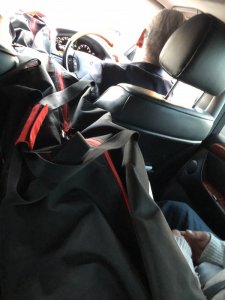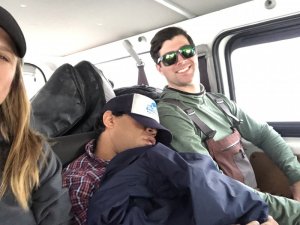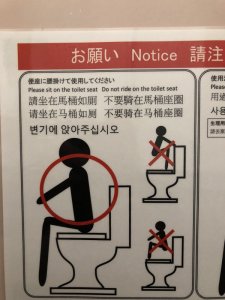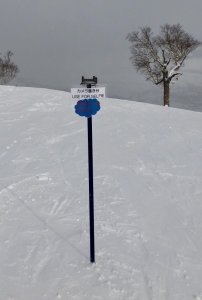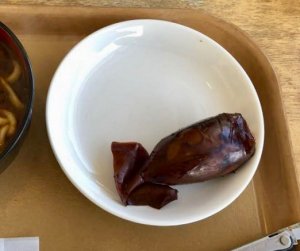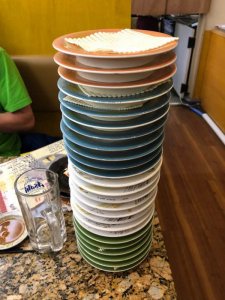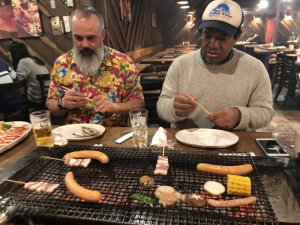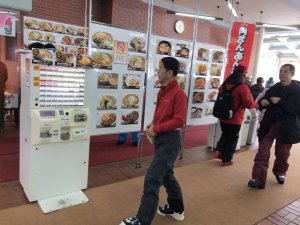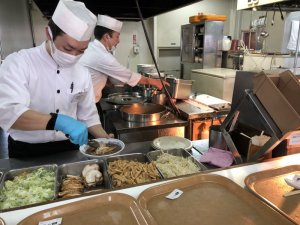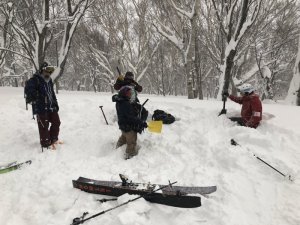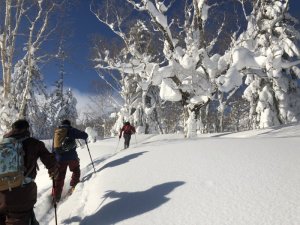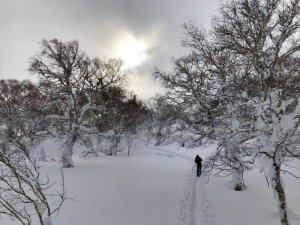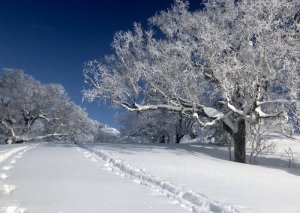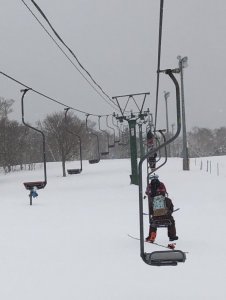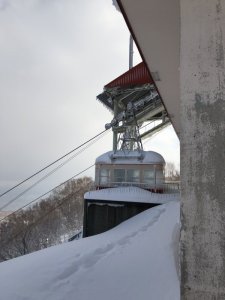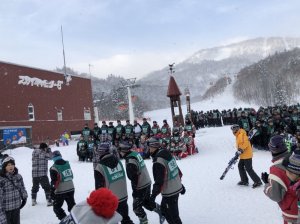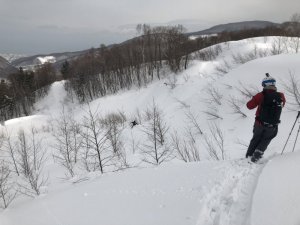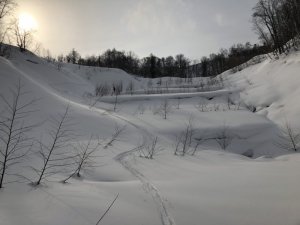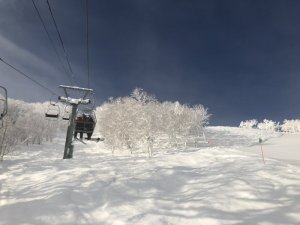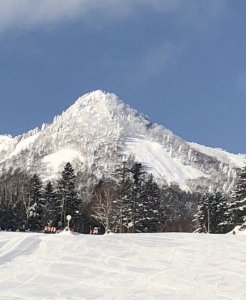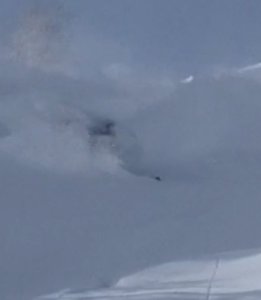Matt has done a blow-by-blow daily report, so my trip report will consist more of general impressions as a first-time visitor to and skier in Japan.
Getting There and Getting Around
I flew into Tokyo and then to Sapporo, with a 14-hr overnight layover. I was meeting @Zach at the Narita airport, which is an hour or so outside Tokyo, and then we were meeting another group member, Paul, down in the Shibuya part of the city. A taxi would have cost almost $300, and I thought we might take the train into downtown, but Zach’s flight was delayed and we were probably going to miss the last one. Plus we had to transfer, with skis, and then walk seven blocks or get a taxi. Hmmmm. So I looked into catching a bus, which it turns out was to drop us right at the hotel front door! Score! And the bus was awesome. It cost about the same as the train (maybe less? I think it was about $30), and was roomy, comfortable, and empty — plus, they handled all your gear for you. When we got into the city and saw how jam-packed the trains were, even at 10:30 pm, we were really grateful for that decision. Paul had arrived by train, and said it kinda stunk.
The next morning we were all flying out of the closer airport, Haneda, but the bus didn’t leave early enough. We decided splitting a taxi three ways wouldn’t be so bad, and it wasn’t, but there was only one option of vehicle, and it wasn’t quite large enough to handle skis. “Luckily” my skis hadn’t made it to Japan yet, and Zach’s bag only had skis in it (Paul is a boarder so his bag fit ok). My fully packed ski bag never would have fit. But we made it!
The guides met us at the airport and drove us in vans the rest of the time; that was much appreciated, because it looked pretty intimidating. I have driven internationally before, in Europe, and while a few things make it slightly stressful, dealing with traffic signs in Japanese and driving on the left side of the road is is a whole nother ball of wax. Not having to worry about getting ourselves around the country was quite the luxury. In addition, tolls were very expensive. I’m pretty sure Matt said transportation was one of the biggest trip charges, and I see why now. Paul and Zach stayed a little longer, taking a bus to Niseko, and said that went mostly smoothly as well.
Lodging
Our first hotel was the Grand Park Otaru, a very nice, familiar style of hotel, though it’s maybe a bit tired. The rooms were large, and we had been upgraded to a beautiful bay view, although it was on a smoking floor. I was a little concerned that I would need to change floors, but it ended up that the hallway was much stinkier than the room, and I didn’t even notice it after the first couple hours.
There is a large mall attached to hotel, with all sorts of restaurants and shops. It was a convenient place to eat dinners and do a little shopping for necessities such as ski wax and kimonos. The supermarket there was kind of overwhelming; I went in but didn’t end up buying anything.
The breakfast buffet was just enormous, with both Western and Eastern fare. I am not a big eater that early in the day, so I didn’t get very creative. I stuck to eggs, cheese and ham slices, aloe cubes (that might sound creative, but it tasted like canned fruit cocktail), yogurt and dried fruit, occasionally the salad bar. The last day I got a little crazy and made an ice cream sundae (yes, vanilla/chocolate/strawberry were choices, too). But you could have eaten everything from shrimp curry to pickled squid to dried mackerel.
Our second hotel, the New Furano Prince, was ski in/ski out, therefore very convenient — the rooms were smaller and more dated, but still entirely adequate. I was staying by myself, but it might get a little cramped if you are sharing. The beds were just as firm as the ones in Otaru, which means very firm, but I thought the bedding was nicer. There were some common areas here for hanging out, even some seating in our hallway. I will say, the constant drone of honest-to-god elevator music everywhere except the private rooms started to get to me after a while.
The breakfast buffet here had a very similar menu but was in a much more sterile banquet hall. The hotel also had a market inside where you could buy all sorts of food, drinks, other necessities, and souvenirs. We went into town for dinners, even though the hotel had several onsite restaurants. The guides had visited before and said they were just a little pricey for what you got; I think this was a good decision, as I enjoyed the restaurants in the town quite a bit, and it was nice to change up the scenery.
Next time I would be interested in staying at smaller lodge-type accommodations, but I’m sure the conveniences of a large hotel are hard to beat.
Japan
The language barrier is real, but not insurmountable. During our first evening (uh, late night) in Tokyo, I was a bit surprised at how little English was spoken even by young adults in the big city. We did find some English menus, even though the translations were sometimes difficult to understand, and some photo menus for pointing, even though the pictures were sometimes difficult to understand. Using Google translate on our phones was a very useful and highly recommended manner of communication.
I had used a Japanese toilet before, and while I thought it was kind of cool that the toilet washed your bum for you, I didn’t really see the need. After 2 weeks on Japanese toilets, I think I will start importing them. Heated toilet seats in ski area restrooms are The Best. They probably make for longer lines, though, as people (ok, I am talking about myself) linger there to warm up.
This leads me to signage … because we all took photos of the signs in the restroom stalls: the explanations and diagrams of how to use and most importantly not use the toilets were really funny. Basically, most of the translated signs just struck us as funny. (I’m sure any attempts to translate English signs into Japanese would be just as funny.)
Onsens … sorry, I didn’t go. The only one we really had access to was attached to the second hotel, and I was the only female on the trip, and I didn’t feel like going through all that rigamarole.
Generally speaking, everyone was very polite and welcoming, aside from a few ski patrol types.

Upon closer inspection ...

Food
Several times the trip was described as a food tour with some skiing thrown in, and I can’t dispute that. The food was excellent, but by the second week I was a bit overwhelmed, especially by pork cutlet, which comes with pretty much everything you can imagine. Of course we had some great sushi and visited some grill restaurants as well. I only ate a few questionable things, including rice-stuffed squid.
Italian seems to be a favorite "ethnic" food; I had pizza at lunch one day and spaghetti another that were both quite good. We visited a couple of sushi trains; I think there are some in the US, but I had never been to one before. Basically you grab what looks good as it comes around. The plates are priced by color, and when you are done, you stack them up and get counted. @Big Salad might need a name change, as he set a record with 25 plates on one of our last nights.
Vending machines are fun. You can get anything anywhere (including Sapporo/Asahi/Kirin), whether buying hot or cold drinks straight from the machine, or submitting a food order that you then pick up from the kitchen.
Oh, and the whiskey. You’re in luck if that’s a favorite.
Prices of course depend on the exchange rate, but except for Tokyo, food and drink seemed a little bit cheaper than in the US. At the ski areas, you could really get a lot of food for less than $10.
The Adventure Project
Matt’s group consisted of three skiers and a boarder; the other guide, Jeremy, had two boarders. We met for breakfast at 6:30 every day to discuss the day’s options based on the weather forecast and possible snowfall (they don’t really do timely, accurate morning reports where we were). Matt was very open to suggestions and requests, but as he knew a lot more about what was going on than we did, we usually agreed with him. I thought he delivered a nice balance of chasing snow and visiting different areas, even though one resort was tagged three times. (Well, it had the best snow! First things first!)
The guides led their groups in beacon training during the first two afternoons; it was very thorough and useful, and honestly much more efficient than my Avy 1 course. It probably helped having had Avy 1 already, but I haven’t practiced much in a couple years, so I needed it. Throughout the trip, we had on-the-fly safety instruction about the snowpack and other dangers such as terrain traps.
Matt has a real powder sniffer and is willing to bushwhack in and out of areas in search of good snow. Those of you who have skied with me know that’s right up my alley. He was always honest when he wasn’t sure what the conditions would be like, and let us choose if we wanted to give it a go or not.
The trip basically consists of 10 straight days of skiing (a couple of those are half days when traveling from Otaru to Furano and then Furano to Chitose), and I knew I would never be able to make them all. Matt was understanding when we needed to quit early, slow it down, or take a day off. But he was willing to go bell to bell when you wanted to!
The guides also helped us with dinner locations every night, again giving us options and sometimes trying new places, again always with the caveat “haven’t been here before, hope it’s good.”
THE SKIING
Well, that’s why we were there, right? The skiing was fabulous, but if you don’t like tree skiing, I wouldn’t recommend this trip. If you just want to lap lifts, that doesn’t work so well, either. You can, but the lift-served on-piste skiing tracks out just like it does in the US: it snowed every day but one, I think, but we didn’t get any enormous dumps or free-refill storms. However, the trees and sidecountry delivered the goods. So yes, we did have to work a little for it. The skins in and traverses out were just beautiful, and I enjoyed them almost as much as the skiing.
We did ride lifts or gondolas every day to at least get to up the gates, and that was an experience. Most transport up the hill is fairly old. You generally have to take your skis inside the gondolas because the ski holders aren’t wide enough, and I found that quite awkward, because the gondola cars aren’t very big, either, and you are wearing a pack. I finally got the hang of it on my very last gondy trip; oh well, good for next time. The pizza box lift looked scary, but I liked it the most because I didn’t need to take off my pack. It wasn’t windy, though; that might change my mind. The other thing is that there are abandoned lifts all over the place, even an abandoned tram and building at Sapporo Teine. I guess it costs too much to take them down.
Japan isn’t known as the steepest skiing in the world, although at Furano and Sapporo Teine, we definitely found a bit of avalanche terrain. Much of the avalanche danger we faced (which wasn't much) comes from wind-loading and terrain traps: we skied through and underneath quite a few drainages and creek beds. When we poked around, most days the snow felt pretty consistent, but there were a few wind events that created some slabs that we had to beware of. We had to be careful around some glide cracks, too. But overall, the snowpack was quite stable (especially in comparison to, say, Colorado).
The resorts themselves felt like ski resorts. Most of the places we visited were small. Tengu reminded me a lot of Sunlight, in Glenwood Springs. Snow sculptures are a thing. Lift tickets were usually somewhere around $40, give or take a few dollars. The one thing that surprised me most was the number of schoolkids there on weekdays. Apparently skiing is part of the Japanese school curriculum, and the students get to spend a few days every year in ski lessons. One day at Kokusai I was pretty floored by the number of students, which went into the hundreds at least. There, the groups were all dressed alike, too, in school-issue clothing and gear, and I admit it was a bit of a strange sight. They stuck to drilling at the bottom of the mountain and we didn't have too much trouble with the gondola line, only once.
The rules varied by resort as far as tree skiing. Matt seemed to have a pretty good bead on whether we needed to be sneaky or not, but he told us that one of the places has two new patrollers who are very picky about the rules. Lucky for us, we visited there when one had the day off, and the other didn't hassle us.
I’ll let pictures tell the rest.
Getting There and Getting Around
I flew into Tokyo and then to Sapporo, with a 14-hr overnight layover. I was meeting @Zach at the Narita airport, which is an hour or so outside Tokyo, and then we were meeting another group member, Paul, down in the Shibuya part of the city. A taxi would have cost almost $300, and I thought we might take the train into downtown, but Zach’s flight was delayed and we were probably going to miss the last one. Plus we had to transfer, with skis, and then walk seven blocks or get a taxi. Hmmmm. So I looked into catching a bus, which it turns out was to drop us right at the hotel front door! Score! And the bus was awesome. It cost about the same as the train (maybe less? I think it was about $30), and was roomy, comfortable, and empty — plus, they handled all your gear for you. When we got into the city and saw how jam-packed the trains were, even at 10:30 pm, we were really grateful for that decision. Paul had arrived by train, and said it kinda stunk.
The next morning we were all flying out of the closer airport, Haneda, but the bus didn’t leave early enough. We decided splitting a taxi three ways wouldn’t be so bad, and it wasn’t, but there was only one option of vehicle, and it wasn’t quite large enough to handle skis. “Luckily” my skis hadn’t made it to Japan yet, and Zach’s bag only had skis in it (Paul is a boarder so his bag fit ok). My fully packed ski bag never would have fit. But we made it!
Yes, you can fit skis into aTokyo taxi
The guides met us at the airport and drove us in vans the rest of the time; that was much appreciated, because it looked pretty intimidating. I have driven internationally before, in Europe, and while a few things make it slightly stressful, dealing with traffic signs in Japanese and driving on the left side of the road is is a whole nother ball of wax. Not having to worry about getting ourselves around the country was quite the luxury. In addition, tolls were very expensive. I’m pretty sure Matt said transportation was one of the biggest trip charges, and I see why now. Paul and Zach stayed a little longer, taking a bus to Niseko, and said that went mostly smoothly as well.
Hashtag van life
Lodging
Our first hotel was the Grand Park Otaru, a very nice, familiar style of hotel, though it’s maybe a bit tired. The rooms were large, and we had been upgraded to a beautiful bay view, although it was on a smoking floor. I was a little concerned that I would need to change floors, but it ended up that the hallway was much stinkier than the room, and I didn’t even notice it after the first couple hours.
There is a large mall attached to hotel, with all sorts of restaurants and shops. It was a convenient place to eat dinners and do a little shopping for necessities such as ski wax and kimonos. The supermarket there was kind of overwhelming; I went in but didn’t end up buying anything.
The breakfast buffet was just enormous, with both Western and Eastern fare. I am not a big eater that early in the day, so I didn’t get very creative. I stuck to eggs, cheese and ham slices, aloe cubes (that might sound creative, but it tasted like canned fruit cocktail), yogurt and dried fruit, occasionally the salad bar. The last day I got a little crazy and made an ice cream sundae (yes, vanilla/chocolate/strawberry were choices, too). But you could have eaten everything from shrimp curry to pickled squid to dried mackerel.
Our second hotel, the New Furano Prince, was ski in/ski out, therefore very convenient — the rooms were smaller and more dated, but still entirely adequate. I was staying by myself, but it might get a little cramped if you are sharing. The beds were just as firm as the ones in Otaru, which means very firm, but I thought the bedding was nicer. There were some common areas here for hanging out, even some seating in our hallway. I will say, the constant drone of honest-to-god elevator music everywhere except the private rooms started to get to me after a while.
The breakfast buffet here had a very similar menu but was in a much more sterile banquet hall. The hotel also had a market inside where you could buy all sorts of food, drinks, other necessities, and souvenirs. We went into town for dinners, even though the hotel had several onsite restaurants. The guides had visited before and said they were just a little pricey for what you got; I think this was a good decision, as I enjoyed the restaurants in the town quite a bit, and it was nice to change up the scenery.
Next time I would be interested in staying at smaller lodge-type accommodations, but I’m sure the conveniences of a large hotel are hard to beat.
Japan
The language barrier is real, but not insurmountable. During our first evening (uh, late night) in Tokyo, I was a bit surprised at how little English was spoken even by young adults in the big city. We did find some English menus, even though the translations were sometimes difficult to understand, and some photo menus for pointing, even though the pictures were sometimes difficult to understand. Using Google translate on our phones was a very useful and highly recommended manner of communication.
I had used a Japanese toilet before, and while I thought it was kind of cool that the toilet washed your bum for you, I didn’t really see the need. After 2 weeks on Japanese toilets, I think I will start importing them. Heated toilet seats in ski area restrooms are The Best. They probably make for longer lines, though, as people (ok, I am talking about myself) linger there to warm up.
This leads me to signage … because we all took photos of the signs in the restroom stalls: the explanations and diagrams of how to use and most importantly not use the toilets were really funny. Basically, most of the translated signs just struck us as funny. (I’m sure any attempts to translate English signs into Japanese would be just as funny.)
Onsens … sorry, I didn’t go. The only one we really had access to was attached to the second hotel, and I was the only female on the trip, and I didn’t feel like going through all that rigamarole.
Generally speaking, everyone was very polite and welcoming, aside from a few ski patrol types.
Photos by Paul Mitchell, Niseko
Food
Several times the trip was described as a food tour with some skiing thrown in, and I can’t dispute that. The food was excellent, but by the second week I was a bit overwhelmed, especially by pork cutlet, which comes with pretty much everything you can imagine. Of course we had some great sushi and visited some grill restaurants as well. I only ate a few questionable things, including rice-stuffed squid.
It tasted about like it looks; photo by @Big Salad
Italian seems to be a favorite "ethnic" food; I had pizza at lunch one day and spaghetti another that were both quite good. We visited a couple of sushi trains; I think there are some in the US, but I had never been to one before. Basically you grab what looks good as it comes around. The plates are priced by color, and when you are done, you stack them up and get counted. @Big Salad might need a name change, as he set a record with 25 plates on one of our last nights.
That's a lot of plates; photo by @Big Salad
Table barbecue in Otaru
We visited a German-style beer hall in Otaru a couple of times; they had a dunkel, a weissbier, and a pilsner that were very tasty and a nice change from the constant stream of Sapporo/Asahi/Kirin.
Vending machines are fun. You can get anything anywhere (including Sapporo/Asahi/Kirin), whether buying hot or cold drinks straight from the machine, or submitting a food order that you then pick up from the kitchen.
Vending machine and lunch at Kokusai
Oh, and the whiskey. You’re in luck if that’s a favorite.
Prices of course depend on the exchange rate, but except for Tokyo, food and drink seemed a little bit cheaper than in the US. At the ski areas, you could really get a lot of food for less than $10.
The Adventure Project
Matt’s group consisted of three skiers and a boarder; the other guide, Jeremy, had two boarders. We met for breakfast at 6:30 every day to discuss the day’s options based on the weather forecast and possible snowfall (they don’t really do timely, accurate morning reports where we were). Matt was very open to suggestions and requests, but as he knew a lot more about what was going on than we did, we usually agreed with him. I thought he delivered a nice balance of chasing snow and visiting different areas, even though one resort was tagged three times. (Well, it had the best snow! First things first!)
The guides led their groups in beacon training during the first two afternoons; it was very thorough and useful, and honestly much more efficient than my Avy 1 course. It probably helped having had Avy 1 already, but I haven’t practiced much in a couple years, so I needed it. Throughout the trip, we had on-the-fly safety instruction about the snowpack and other dangers such as terrain traps.
Beacon training at Tengu
Matt has a real powder sniffer and is willing to bushwhack in and out of areas in search of good snow. Those of you who have skied with me know that’s right up my alley. He was always honest when he wasn’t sure what the conditions would be like, and let us choose if we wanted to give it a go or not.
The trip basically consists of 10 straight days of skiing (a couple of those are half days when traveling from Otaru to Furano and then Furano to Chitose), and I knew I would never be able to make them all. Matt was understanding when we needed to quit early, slow it down, or take a day off. But he was willing to go bell to bell when you wanted to!
The guides also helped us with dinner locations every night, again giving us options and sometimes trying new places, again always with the caveat “haven’t been here before, hope it’s good.”
THE SKIING
Well, that’s why we were there, right? The skiing was fabulous, but if you don’t like tree skiing, I wouldn’t recommend this trip. If you just want to lap lifts, that doesn’t work so well, either. You can, but the lift-served on-piste skiing tracks out just like it does in the US: it snowed every day but one, I think, but we didn’t get any enormous dumps or free-refill storms. However, the trees and sidecountry delivered the goods. So yes, we did have to work a little for it. The skins in and traverses out were just beautiful, and I enjoyed them almost as much as the skiing.
Kokusai
Kokusai
Furano
We did ride lifts or gondolas every day to at least get to up the gates, and that was an experience. Most transport up the hill is fairly old. You generally have to take your skis inside the gondolas because the ski holders aren’t wide enough, and I found that quite awkward, because the gondola cars aren’t very big, either, and you are wearing a pack. I finally got the hang of it on my very last gondy trip; oh well, good for next time. The pizza box lift looked scary, but I liked it the most because I didn’t need to take off my pack. It wasn’t windy, though; that might change my mind. The other thing is that there are abandoned lifts all over the place, even an abandoned tram and building at Sapporo Teine. I guess it costs too much to take them down.
Pizza box lift at Tengu
Abandoned tram at Sapporo Teine
Japan isn’t known as the steepest skiing in the world, although at Furano and Sapporo Teine, we definitely found a bit of avalanche terrain. Much of the avalanche danger we faced (which wasn't much) comes from wind-loading and terrain traps: we skied through and underneath quite a few drainages and creek beds. When we poked around, most days the snow felt pretty consistent, but there were a few wind events that created some slabs that we had to beware of. We had to be careful around some glide cracks, too. But overall, the snowpack was quite stable (especially in comparison to, say, Colorado).
The resorts themselves felt like ski resorts. Most of the places we visited were small. Tengu reminded me a lot of Sunlight, in Glenwood Springs. Snow sculptures are a thing. Lift tickets were usually somewhere around $40, give or take a few dollars. The one thing that surprised me most was the number of schoolkids there on weekdays. Apparently skiing is part of the Japanese school curriculum, and the students get to spend a few days every year in ski lessons. One day at Kokusai I was pretty floored by the number of students, which went into the hundreds at least. There, the groups were all dressed alike, too, in school-issue clothing and gear, and I admit it was a bit of a strange sight. They stuck to drilling at the bottom of the mountain and we didn't have too much trouble with the gondola line, only once.
The rules varied by resort as far as tree skiing. Matt seemed to have a pretty good bead on whether we needed to be sneaky or not, but he told us that one of the places has two new patrollers who are very picky about the rules. Lucky for us, we visited there when one had the day off, and the other didn't hassle us.
I’ll let pictures tell the rest.
A small fraction of the school groups at Kokusai
No new snow today, so we had to look for it at Asari
A new experience was skiing the dam walls at Asari
A classic bluebird pow day at Furano
Who says Japan isn't steep? The Diamond at Furano
Someone, somewhere ...
Last edited:

